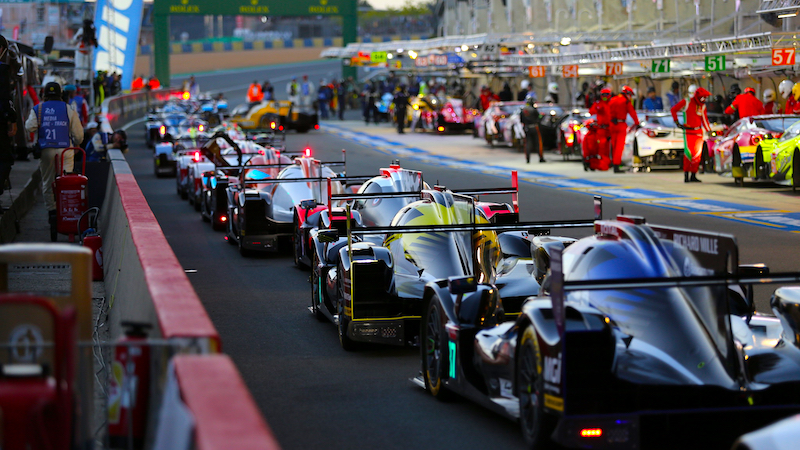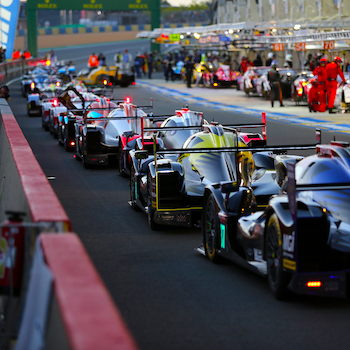The 2020/2021 FIA World Endurance Championship will mark the debut of the brand-new Le Mans Hypercar class. We have taken a look at what we know so far about the future premiere class of prototype racing.

Will Le Mans Hypercar replace current prototypes?
This new evolution of regulations in the top class of sportscar prototype racing is a clear step away from the previous iteration of LMP1 regulations. The new regulations can, in many ways, be considered as the start of a new era in this form of racing.
The maiden season for the new regulations will be 2020/2021. The LMP1 category in the FIA World Endurance Championship will be replaced by LMH, or Le Mans Hypercar. LMP1 cars can currently only race in the WEC, and this will continue to be the case for the LMH class – for the time being at least.
LMP cars will, however, not disappear from our radar. The LMP2 will continue to be run as part of the FIA World Endurance Championship and additionally as the top class in the European Le Mans Series and the Asian Le Mans Series. A new set of LMP2 regulations is due in 2021.
What will the Le Mans Hypercars look like?
Unlike the LMP1 class, manufacturers in the LMH category will have more freedom in terms of car design, performance and overall approach.
Manufacturers can choose two different routes when developing cars for the LMH class. They will either be able to design pure prototype machinery or adapt road-going models for competition. For road-going LMHs, there are minimum requirements for the number of cars sold.
Hybrid drivetrains are no longer a requirement, as they were for manufacturers in the LMP1 class. Competitors can choose between pure internal combustion engines or systems involving hybrid systems. Power is restricted to 750 hp and hybrid power of 270 hp. From 2024, hydrogen engines or hydrogen-based hybrid systems will be permitted.
Maximum car lengths, heights and breadths have been defined. LMHs are permitted to run one moveable aerodynamic device, however only one bodywork concept will be permitted per season. In the past manufacturers have been permitted to develop two or more sets of bodywork, giving rise to special “low-drag” set-ups for Le Mans.
Which manufacturers will be racing in Le Mans Hypercar?
The first season of the Le Mans Hypercar category will see factory entries from Toyota and Aston Martin, with Peugeot set to follow from 2022/2023 (season three) or quite possibly late on in 2021/2022 (season two). In addition, US manufacturer Glickenhaus will be racing their SCG 007 from 2020/2021, with an as-yet-unknown further entry from Germany-based ByKolles.
The three main manufacturers will be entering at least two cars each. Toyota’s GT Super Sport is a prototype LMH with a hybrid system and a small internal combustion engine, while Aston Martin’s Valkerie will feature a monster V12 motor and no hybrid drive. Peugeot have confirmed a partnership with current LMP1 team Rebellion Racing and that the car will feature a hybrid system.
Alongside confirmed competitors there is a series of potential teams and manufacturers taking a serious look at the category. The likes of McLaren, Ferrari, Lamborghini and Koenigsegg are said to be eyeing up an LMH, although some appear to be waiting for the right time to join.
Will privateer hypercars be permitted?
According to the latest clarification of the regulations for the LMH, teams must enter the class together with an “automotive brand”. However, the definition of the term is relatively broad, and in addition the FIA Endurance Committee can approve entries on a case-by-case basis if they see fit.
Rebellion Racing’s partnership with Peugeot is one such possibility of privateer teams trying their hand at the LMH class. Glickenhaus too is considered to be an automotive brand, despite the US manufacturer only producing around 350 cars per year.
What about close racing?
The relatively broad range of potential designs is intended to entice as many manufacturers as possible to the FIA WEC and the 24 Hours of Le Mans. This does come at a cost, however.
Car performance will be equalised through a balance of performance concept similar to the system currently used in GTE Pro. Here, an algorithmic, AI-supported formula makes adjustments to cars on a race-by-race basis to prevent any team gaining too much of an advantage by spending more money.
It is unclear how the system will function, although there will likely be a number of levers the ACO can adjust – including hybrid power deployment, engine restrictor size and weight – to ensure a level playing field.
The current success ballast system in use in the LMP1 class is not expected to be retained for the LMH category.
Will changes have to be made to the LMP2 class?
Yes. The current LMP2s are quicker than the performance set to be delivered by the LMHs. As a result, they will have to be slowed.
ACO sporting director Vincent Beaumesnil has already announced a 30 kW reduction in power output and the introduction of a spec tyre supplier in the shape of Goodyear.
Will there be any tyre competition in LMH?
The subject of tyres is a complicated one in the WEC, with tyre manufacturers coming and going and regulations being loosened and tightened as the years go out. Michelin is currently set to be the sole tyre supplier in LMH, as it has been for a number of years in LMH.
Rumours of Dunlop’s involvement have cooled after parent company Goodyear was named as the spec tyre supplier in LMP2.
Will a World Championship be awarded in LMH?
The FIA World Endurance Championship will continue to be awarded to both drivers and manufacturers as has been the case in LMP1.

